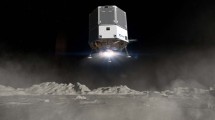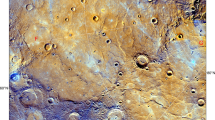Abstract
In this White Paper, submitted to ESA in response to the Voyage 2050 Call, we advocate for establishing key scientific priorities for the future of Mercury exploration, including the development of specific science goals for a landed mission. We support the Mercury science community in fostering closer collaboration with ongoing and planned exoplanet investigations. The continued exploration of Mercury should be conceived as a multi-mission, multi-generational effort, and the landed exploration of Mercury should be a high scientific priority in the coming decades.






Similar content being viewed by others
Data availability
Not applicable.
Code availability
Not applicable.
References
Solomon, SC, et al.: Return to Mercury: A global perspective on MESSENGER’s first Mercury flyby. Science 321, 59–62(2008). https://doi.org/10.1126/science.1159706
Benkhoff, J, et al.: BepiColombo –Comprehensive exploration of Mercury: Mission overview and science goals. Planet. Space Sci. 58, 2–20(2010). https://doi.org/10.1016/j.pss.2009.09.020
National Research Council: Vision and Voyages for Planetary Science in the Decade 2013–2022. The National Academies Press, Washington, DC (2011). https://doi.org/10.17226/13117
Nittler, L.R., et al.: The major-elementcomposition of Mercury’s surface from MESSENGER X-rayspectrometry. Science 333, 1,847–1,850 (2011). https://doi.org/10.1126/science.1211567
Peplowski, P.N., et al.: Radioactive elements on Mercury’s surface from MESSENGER: Implications for the planet’s formation and evolution. Science 333, 1,850–1,852 (2011). https://doi.org/10.1126/science.1211576
Zolotov, M.Y., et al.: Implications of the MESSENGER discovery of high sulfur abundance on the surface of Mercury. EOS(Transactions, American Geophysical Union) American Geophysical Union, San Francisco, pp. abstract # P41A-1584 (2011)
McCubbin, F.M., et al.: A low O/Si ratio on the surface of Mercury: Evidence for silicon smelting? J. Geophys. Res. Planets 122, 2,053–2,076 (2017). https://doi.org/10.1002/2017JE005367
Peplowski, PN, et al.: Geochemical terranes of Mercury’s northern hemisphere as revealed by MESSENGER neutron measurements. Icarus 253, 346–363(2015). https://doi.org/10.1016/j.icarus.2015.02.002
Weider, SZ, et al.: Evidence for geochemical terranes on Mercury: Global mapping of major elements with MESSENGER’s X-RaySpectrometer. Earth Planet. Sci. Lett. 416, 109–120(2015). https://doi.org/10.1016/j.epsl.2015.01.023
Vander Kaaden, KE, et al.: Geochemistry, mineralogy, and petrology of boninitic and komatiitic rocks on the mercurian surface: Insights into the mercurian mantle. Icarus 285, 155–168(2017). https://doi.org/10.1016/j.icarus.2016.11.041
Albarède, F.: Volatile accretion history of the terrestrial planets and dynamic implications. Nature 461, 1,227–1,233 (2009)https://doi.org/10.1038/nature08477
Peplowski, PN, et al.: Enhanced sodium abundance in Mercury’s north polar region revealed by the MESSENGER Gamma-RaySpectrometer. Icarus 228, 86–95(2014). https://doi.org/10.1016/j.icarus.2013.09.007
Peplowski, PN, et al.: Constraints on the abundance of carbon in near-surfacematerials on Mercury: Results from the MESSENGER Gamma-RaySpectrometer. Planet. Space Sci. 108, 98–107(2015). https://doi.org/10.1016/j.pss.2015.01.008
Nittler, L.R., Chabot, N.L., Grove, T.L., Peplowski, P.N.: The chemical composition of Mercury. In: Solomon, S. C., Nittler, L. R., and Anderson, B. J. (eds.) Mercury: The View after MESSENGER, pp. 30–51. Cambridge Planetary Science (2018)
Vander Kaaden, K.E., et al.: Mercury sample return to revolutionize our understanding of the solar system, 2023–2032. Decadal Survey White Paper (2020)
Gladman, B, Coffey, J: Mercurian impact ejecta: Meteorites and mantle. Meteorit. Planet. Sci. 44, 285–291(2009). https://doi.org/10.1111/j.1945-5100.2009.tb00734.x
Ash, ME, Shapiro, II, Smith, WB: The system of planetary masses. Science 174, 551–556(1971). https://doi.org/10.1126/science.174.4009.551
Smith, DE, et al.: Gravity field and internal structure of Mercury from MESSENGER. Science 336, 214–217(2012). https://doi.org/10.1126/science.1218809
Ebel, D.S., Stewart, S.T.: The elusive origin of Mercury. In: Solomon, S.C., Nittler, L.R., Anderson, B. (eds.) Mercury: The View after MESSENGER, pp. 496–514. J. Cambridge Planetary Science (2018)
Margot, J.-L., Hauck, S.A., Mazarico, I.I., Padovan, E., S., and Peale, S.J.: Mercury’s internal structure. In: Solomon, S. C., Nittler, L. R., and Anderson, B. J. (eds.) Mercury: The View after MESSENGER, pp. 85–113. Cambridge Planetary Science (2018)
Williams, J.-P., Ruiz, J., Rosenburg, M.A., Aharonson, O., Phillips, R.J.: Insolation driven variations of Mercury’s lithospheric strength. J. Geophys. Res. Planets 116, E01008 (2011). https://doi.org/10.1029/2010JE003655
Padovan, S, Margot, J-L, Hauck, SA, Moore, II, Solomon, SC: The tides of Mercury and possible implications for its interior structure. Journal of Geophysical Research Planets 119, 850–866(2014). https://doi.org/10.1002/2013JE004459
Steinbrügge, G., et al.: Viscoelastic tides of Mercury and the determination of its inner core size. J. Geophys. Res. Planets 123, 2760–2772(2018). https://doi.org/10.1029/2018je005569
Banks, M.E., et al.: Duration of activity on lobate-scarpthrust faults on Mercury. J. Geophys. Res. Planets 120, 1,751–1,762 (2015). https://doi.org/10.1002/2015JE004828
Lammlein, DR: Lunar seismicity and tectonics. Phys. Earth Planet. Inter. 14, 224–273(1977). https://doi.org/10.1016/0031-9201(77)90175-3
Nakamura, Y: Farside deep moonquakes and deep interior of the Moon. Journal of Geophysical Research: Planets 110, E01001 (2005). https://doi.org/10.1029/2004je002332
Dorman, J., et al.: On the time-varyingproperties of the lunar seismic meteoroid population. Lunar Planet. Sci. Conf. Proc. 9, 3615–3626 (1978)
Oberst, J, Nakamura, Y: A search for clustering among the meteoroid impacts detected by the Apollo lunar seismic network. Icarus 91, 315–325(1991). https://doi.org/10.1016/0019-1035(91)90027-Q
Le Feuvre, M, Wieczorek, MA: Nonuniform cratering of the Moon and a revised crater chronology of the inner Solar System. Icarus 214, 1–20(2011). https://doi.org/10.1016/j.icarus.2011.03.010
Banerdt, W.B., et al.: InSight: An integrated exploration of the interior of Mars. 43rd Lunar and Planetary Science Conference, abstract 2838 (2012)
Stark, A, et al.: First MESSENGER orbital observations of Mercury’s librations. Geophys. Res. Lett. 42, 7881–7889(2015). https://doi.org/10.1002/2015gl065152
Dehant, V., et al.: Revealing Mars’ deep interior: Future geodesy missions using radio links between landers, orbiters, and the Earth. Planet. Space Sci. 59, 1,069–1,081. (2011). https://doi.org/10.1016/j.pss.2010.03.014
Genova, A, et al.: Geodetic evidence that Mercury has a solid inner core. Geophys. Res. Lett. 46, 3625–3633(2019). https://doi.org/10.1029/2018gl081135
Stanley, S, Bloxham, J, Hutchinson, WE, Zuber, MT: Thin shell dynamo models consistent with Mercury’s weak surface magnetic field. Earth Planet. Sci. Lett. 234, 27–38(2005). https://doi.org/10.1016/j.epsl.2005.02.040
James, P.B., Zuber, M.T., Phillips, R.J., Solomon, S.C.: Support of long-wavelengthtopography on Mercury inferred from MESSENGER measurements of gravity and topography. J. Geophys. Res. Planets 120, 287–310(2015). https://doi.org/10.1002/2014JE004713
Johnson, C.L., et al.: MESSENGER observations of induced magnetic fields in Mercury’s core. Geophys. Res. Lett. 43, 2,436–2,444. (2016). https://doi.org/10.1002/2015GL067370
Zhang, Z., Pommier, A.: Electrical investigation of metal-olivinesystems and application to the deep interior of Mercury. J. Geophys. Res. Planets 122, 2,702–2,718 (2017). https://doi.org/10.1002/2017JE005390
Noda, H, Heki, K, Hanada, H: In situ Lunar Orientation Measurement (ILOM): Simulation of observation. Adv. Space Res. 42, 358–362(2008). https://doi.org/10.1016/j.asr.2007.01.025
Zuber, MT, et al.: Gravity field of the Moon from the Gravity Recovery and Interior Laboratory (GRAIL)mission. Science 339, 668–671(2013). https://doi.org/10.1126/science.1231507
Drinkwater, M, Floberghagen, R, Haagmans, R, Muzi, D, Popescu, A: GOCE: ESA’s first Earth Explorer core mission. Space Sci. Rev. 108, 419–432(2003). https://doi.org/10.1007/978-94-017-1333-7_36
Griggs, C.E., et al.: Tunable superconducting gravity gradiometer for Mars climate, atmosphere, and gravity field investigation. 46th Lunar and Planetary Science Conference, abstract 1735 (2015)
Denevi, B.W., et al.: The distribution and origin of smooth plains on Mercury. J. Geophys. Res. Planets 118, 891–907(2013). https://doi.org/10.1002/jgre.20075
Marchi, S, et al.: Global resurfacing of Mercury 4.0–4.1 billion years ago by heavy bombardment and volcanism. Nature 499, 59–61(2013). https://doi.org/10.1038/nature12280
Byrne, PK, et al.: Mercury’s global contraction much greater than earlier estimates. Nat. Geosci. 7, 301–307(2014). https://doi.org/10.1038/ngeo2097
Byrne, P.K., et al.: Widespread effusive volcanism on Mercury likely ended by about 3.5 Ga. Geophys. Res. Lett. 43, 7,408–7,416 (2016).https://doi.org/10.1002/2016GL069412
Watters, T.R., et al.: Distribution of large-scalecontractional tectonic landforms on Mercury: Implications for the origin of global stresses. Geophys. Res. Lett. 42, 3,755–3,763 (2015). https://doi.org/10.1002/2015gl063570
Johnson, CL, et al.: Low-altitude magnetic field measurements by MESSENGER reveal Mercury’s ancient crustal field. Science 348, 892–895 (2015). https://doi.org/10.1126/science.aaa8720
Hood, L.L.: Magnetic anomalies concentrated near and within Mercury’s impact basins: Early mapping and interpretation. J. Geophys. Res. Planets. 121, 1,016–1,025 (2016). https://doi.org/10.1002/2016JE005048
Strauss, B.E., Feinberg, J.M., Johnson, C.L.: Magnetic mineralogy of the Mercurian lithosphere. J. Geophys. Res. Planets 121, 2,225–2,238 (2016). https://doi.org/10.1002/2016JE005054
Anderson, B.J., et al.: Steady-statefield-aligned currents at Mercury. Geophys. Res. Lett. 41, 7,444–7,452 (2014). https://doi.org/10.1002/2014GL061677
Domingue, DL, et al.: Mercury’s weather-beatensurface: Understanding Mercury in the context of lunar and asteroidal space weathering studies. Space Sci. Rev. 181, 121–214(2014). https://doi.org/10.1007/S11214-014-0039-5
Martinez, R, et al.: Sputtering of sodium and potassium from nepheline: Secondary ion yields and velocity spectra. Nucl. Instrum. Methods Phys. Res., Sect. B 406, 523–528(2017). https://doi.org/10.1016/j.nimb.2017.01.042
Merkel, AW, et al.: Evidence connecting Mercury’s magnesium exosphere to its magnesium-richsurface terrane. Geophys. Res. Lett. (2018). https://doi.org/10.1029/2018GL078407
Blewett, D.T., et al.: Analysis of MESSENGER high-resolutionimages of Mercury’s hollows and implications for hollow formation. J. Geophys. Res. Planets 121, 1,798–1,813 (2016).https://doi.org/10.1002/2016JE005070
Blewett, D.T., et al.: Hollows on Mercury: Evidence for geologically recent volatile-relatedactivity. Science 333, 1,856–1,859 (2011). https://doi.org/10.1126/science.1211681
Helbert, J., et al.: Olivine thermal emissivity under extreme temperature ranges: Implication for Mercury surface. Earth Planet. Sci. Lett. 371–372, 252–257 (2013). https://doi.org/10.1016/j.epsl.2013.03.038
Ferrari, S, et al.: In-situ high-temperature emissivity spectra and thermal expansion of C2/c pyroxenes: Implications for the surface of Mercury. Am. Miner. 99, 786–792 (2014). https://doi.org/10.2138/am.2014.4698
Slade, MA, Butler, BJ, Muhleman, DO: Mercury radar imaging: Evidence for polar ice. Science 258, 635–640(1992). https://doi.org/10.1126/science.258.5082.635
Harmon, JK, Slade, MA: Radar mapping of Mercury: Full-diskimages and polar anomalies. Science 258, 640–643(1992). https://doi.org/10.1126/science.258.5082.640
Butler, B.J., Muhleman, D.O., Slade, M.A.: Mercury: Full-diskradar images and the detection and stability of ice at the north pole. J. Geophys. Res. 98, 15,003–15,023 (1993). https://doi.org/10.1029/93JE01581
Harmon, JK, Slade, MA, Rice, MS: Radar imagery of Mercury’s putative polar ice: 1999–2005Arecibo results. Icarus 211, 37–50(2011). https://doi.org/10.1016/j.icarus.2010.08.007
Deutsch, AN, et al.: Comparison of areas in shadow from imaging and altimetry in the north polar region of Mercury and implications for polar ice deposits. Icarus 280, 158–171(2016). https://doi.org/10.1016/j.icarus.2016.06.015
Chabot, N.L., Shread, E.E., Harmon, J.K.: Investigating Mercury’s south polar deposits: Arecibo radar observations and high-resolutiondetermination of illumination conditions. J. Geophys. Res. Planets 123, 666–681(2018). https://doi.org/10.1002/2017JE005500
Paige, DA, et al.: Thermal stability of volatiles in the north polar region of Mercury. Science 339, 300–303(2013). https://doi.org/10.1126/science.1231106
Lawrence, DJ, et al.: Evidence for water ice near Mercury’s north pole from MESSENGER Neutron Spectrometer measurements. Science 339, 292–296(2013). https://doi.org/10.1126/science.1229953
Neumann, GA, et al.: Bright and dark polar deposits on Mercury: Evidence for surface volatiles. Science 339, 296–300(2013). https://doi.org/10.1126/science.1229764
Chabot, N.L., et al.: Imaging Mercury’s polar deposits during MESSENGER’s low-altitudecampaign. Geophys. Res. Lett. 43, 9,461–9,468 (2016). https://doi.org/10.1002/2016GL070403
Deutsch, A.N., et al.: Science opportunities offered by Mercury’s ice-bearingpolar deposits. 2023–2032Decadal Survey White Paper (2020)
Grard, R, Novara, M, Scoon, G: BepiColombo –A multidisciplinary mission to a hot planet. ESA Bull. 103, 11–19(2000)
Boehnhardt, H, et al.: The Philae lander mission and science overview. Philos. Trans. R. Soc. A Math. Phys. Eng. Sci. 375, 20160248 (2017). https://doi.org/10.1098/rsta.2016.0248
Ho, T.-M., et al.: MASCOT—The mobile asteroid surface scout onboard the Hayabusa2 mission. Space Sci. Rev. 208, 339–374 (2017). https://doi.org/10.1007/s11214-016-0251-6
Ernst, C.M., et al.: Mercury lander planetary mission concept study. Report submitted to NASA and the planetary science and astrobiology decadal survey, arXiv:2107.06795 (2020)
Santerne, A., et al.: An Earth-sizedexoplanet with a Mercury-likecomposition. Nat. Astron. 2, 393–400(2018). https://doi.org/10.1038/s41550-018-0420-5
Author information
Authors and Affiliations
Contributions
All authors contributed to the writing of this paper, and read and approved the final manuscript.
Corresponding author
Ethics declarations
Conflict of interest
The authors declare that they have no conflict of interest.
Additional information
Publisher’s Note
Springer Nature remains neutral with regard to jurisdictional claims in published maps and institutional affiliations.
Rights and permissions
About this article
Cite this article
Byrne, P.K., Blewett, D.T., Chabot, N.L. et al. The case for landed Mercury science. Exp Astron 54, 561–573 (2022). https://doi.org/10.1007/s10686-021-09788-8
Received:
Accepted:
Published:
Issue Date:
DOI: https://doi.org/10.1007/s10686-021-09788-8




